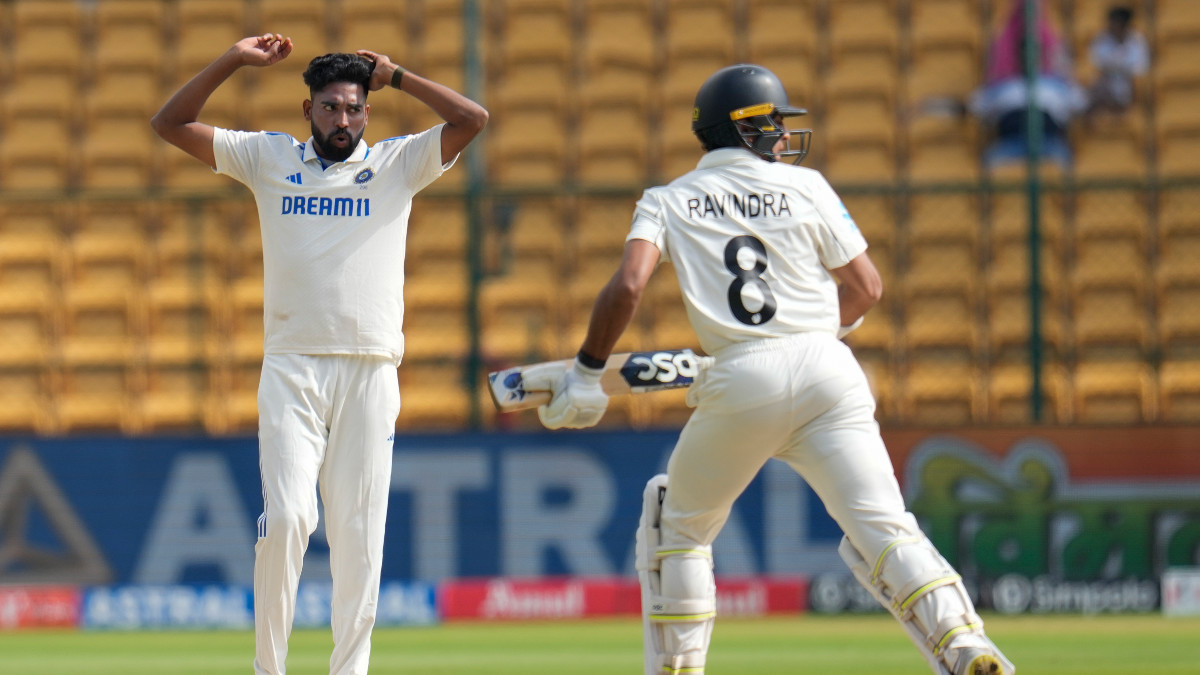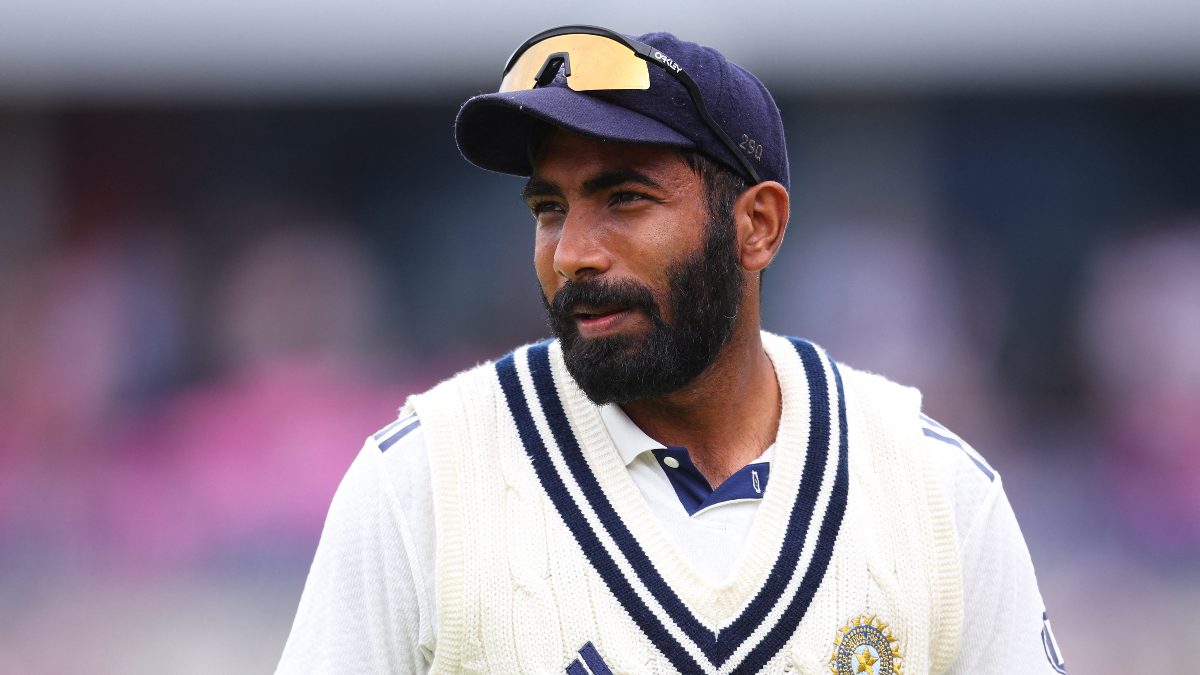India had played themselves so far behind the eight-ball on the scheduled second day that they needed to be fully switched on from the beginning, and for the rest of, New Zealand’s first innings. To mount a fightback after being rolled over for 46 is a near-impossibility, and especially once the Kiwis ensured there were no early hiccups, the magnitude of the challenge staring the Indians in the face multiplied manifold.
By close of Thursday’s play at the M Chinnaswamy Stadium, New Zealand were already 134 runs to the good; at 180 for three and with plenty of batting to follow, they could bat India out of the first Test, particularly with the ball 50 overs old and therefore having gone a bit soft. India’s best bet was to somehow pick up a few early wickets, because without resorting to adventurism, New Zealand’s batting line-up is such that it will make time spent in the middle count.
Blue skies greeted the teams on Friday morning, unlike on the two previous days, but Rohit Sharma still went to Mohammed Siraj and Jasprit Bumrah to exploit whatever advantage might accrue from a 9.15 am start. Despite the grasslessness of the track, seam movement was still available, even if not as pronounced as on the previous morning. To their credit, India’s two quicks stuck to their task, keeping things tight, moving the ball a little this way, a little more that, and shackling Rachin Ravindra and Daryl Mitchell, the overnight pair.
Ravindra had struck an ominous note by whipping the day’s first ball, from Siraj, through mid-wicket for four, but that was almost a false dawn because both quicks found their lengths and probed away relentlessly. Reward wasn’t long in coming. Somewhat frustrated that he wasn’t allowed to score at his normal pace, the right-handed Mitchell flashed at Siraj off the backfoot and was smartly snaffled by Yashasvi Jaiswal at gully, a position he has made his own in recent times.
Impact Shorts
More ShortsBumrah at the other end was desperately unlucky not to be rewarded for his toils until he produced a trademark wicket, forcing Tom Blundell to edge to KL Rahul at second slip. Bumrah is a master at setting batters up; he kept bringing balls back into Blundell, then got one to straighten and catch the edge. Simple. Elementary.
Both went out of the attack after five overs apiece; between them, they took two for 34 and while Ravindra was batting beautifully, his mates were starting to desert him. Enter Ravindra Jadeja, India’s best bowler on the second evening. The left-arm spinner was expected to play second fiddle to R Ashwin and Kuldeep Yadav but emerged as the lead tweaker, with the sticks of Glenn Phillips and Matt Henry in successive overs. A little over an hour and a quarter into the day’s play, New Zealand had lost four for 53. At 233 for seven, India were wonderfully placed to minimise the damage and use their batting strength to make a match of it. That’s when they lost the plot. Completely.
Tim Southee is no mug – he came into this Test with six half-centuries – but he is not the most accomplished bat either. Perhaps that had something to do with Ravindra deciding it was time to shed the shackles and take matters into his own hands. The classy left-hander brought up his 50 in 88 deliveries, showing his hand with a couple of aggressive strokes off Kuldeep that signalled a change of gears.
Read | Southee breaks Sehwag's record, Ravindra hits memorable hundred as NZ take 356-run lead vs India
Rohit took note, as did his bowlers. Maybe they were so intent on keeping Ravindra quiet that they took their eyes off the Southee ball, because it was the tall paceman who inflicted serious and unexpected damage.
Rohit took the wrist-spinner off after a bouquet of three fours in one over, going with an all finger-spin attack in Jadeja and Ashwin. That was a mistake; to lower-order batters such as Southee, wrist-spin remains a big mystery. If New Zealand’s plan was to take their chances against Kuldeep in the hope that he would be replaced, it paid handsome dividends.
Ashwin, only brought on in the day’s 22nd over, had a morning to forget. He couldn’t have been stiff after his exertions of the previous day – he was dismissed first ball and bowled only 11 overs – but he appeared bereft of ideas and imagination, either bowling too full or dragging the ball down. Maybe that became infectious because Jadeja also veered from his disciplines somewhat, runs coming freely from both ends.
The first of Ashwin’s many loose offerings was a full toss that Ravindra smashed over wide mid-wicket for six. That set off a flurry of boundaries against left- and right-arm spin, though at this point, it was only Ravindra who shifted to a higher gear. India spread the field wide in a bid to staunch the bleeding, in the conviction that it was only a matter of time before Southee paid the price for being too attacking, but in doing so, they were powerless to either stop the boundaries or the constant turning over of the strike once Ravindra believed Southee had got his eye in.
The senior pro didn’t disappoint, latching on to Ashwin with unrestrained delight even as Ravindra clattered through the 80s and the 90s to bring up a wonderful second Test century . India wore a hangdog look, their positivity and sense of purpose of the morning having run into an immovable roadblock in the form of the eighth-wicket partnership that fetched 137. That quantum of runs was damaging enough; that those runs came in just an hour and a half and a mere 132 deliveries merely highlighted how dispirited and profligate India were, Southee rattling to a 57-ball fifty in a damning indictment of India’s raggedness.
Ashwin went for 35 in his last two overs and conceded 20 in his last, the most runs he has haemorrhaged in a single Test over. His five overs on Friday leaked 48, largely responsible for the Kiwis adding 165 in just 31 overs in an extended first session. The plight of India’s most experienced and prolific active bowler reflected the travails of a bowling group shortchanged by the batting unit but hardly covering itself in glory either.


)

)
)
)
)
)
)
)
)



